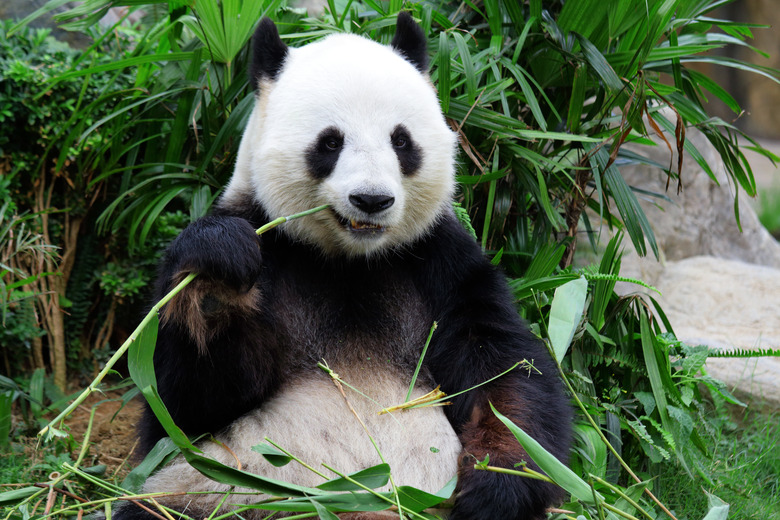How Do Giant Pandas Survive?
The cuddly looking giant panda is the rarest and most endangered species of the bear family. Its distinctive black and white markings, fluffy coat and ponderous, waddling walk endear the giant panda to people all around the world. These beautiful animals are among the world's most threatened species with only about 1,600 left in the wild. Giant pandas can't continue to survive in the wild without human protection.
Where Giant Pandas Live
Where Giant Pandas Live
Wild giant pandas inhabit a mountainous area in southwest China including Gansu, Shaanxi, and Sichuan provinces. In the past they roamed a much larger area that included the lowlands, but human development drove them into the mountains and continues to threaten the wild population on unprotected lands. Wild giant pandas currently live only in the dense bamboo underbrush of the mountain forests.
What Giant Pandas Eat
What Giant Pandas Eat
Wild pandas eat mostly bamboo with some other grasses and an occasional small animal for variety. On average, an adult panda eats 20 to 40 pounds of bamboo every day and spends up to 16 hours a day finding and eating food. Pandas eat sitting upright, holding bamboo stalks between their paws.
Why Giant Pandas are Endangered
Why Giant Pandas are Endangered
Several factors contribute to diminishing the wild panda population. Logging deforestation common in China prior to 1998 destroyed and fragmented panda habitats, leaving fewer places for pandas to live. Deforested areas, roads and human habitation isolated small panda populations, reducing the available gene pool necessary for a healthy population. The expanding Chinese population–along with road and railroad construction, dam building, rural and city expansion and tourism–continues to encroach on natural panda habitats. Poachers also pose a constant danger to wild pandas. The rare and beautiful pelt of the giant panda is highly prized on the black market.
Giant Panda Breeding
Giant Panda Breeding
In addition to human issues, the slow breeding cycle of the giant panda poses a natural problem. Giant pandas begin breeding at four to eight years old and may continue for 12 to 16 years. They ovulate only once a year, in the spring, and only for a few days. Those few days are the only opportunity for a female panda to conceive. Like other species of bear, the giant panda does not live in a pack–it is a solitary, territorial animal. If human construction lies between an ovulating female and the nearest male, the opportunity to breed is lost for a full year.
If two pandas mate successfully, the gestation period is 95 to 160 days. Pandas sometimes give birth to two cubs, but usually only one survives. The cub stays with its mother for two to three years. Under the best of circumstances, a wild female panda can successfully raise a maximum of eight cubs during her lifetime.
Pandas do not breed well outside their natural habitats. Only six females born in captivity have successfully birthed cubs.
Helping Giant Pandas Survive
Helping Giant Pandas Survive
Giant pandas are in the forefront of conservationist efforts. The Chinese government banned logging in 1998 to stop deforestation and created a number of protected areas where no development is allowed. But half of the wild panda population still lives outside protected areas, and 300,000 humans live in unprotected natural panda habitats. Groups working to save the giant panda have established a breeding program, are working with the Chinese government to protect 100 percent of known panda habitats and have a plan to reforest panda habitats and build green corridors–areas of forested greenbelt that connect isolated panda habitats to facilitate breeding.
Cite This Article
MLA
Gray, Sherry. "How Do Giant Pandas Survive?" sciencing.com, https://www.sciencing.com/do-giant-pandas-survive-6622057/. 13 March 2018.
APA
Gray, Sherry. (2018, March 13). How Do Giant Pandas Survive?. sciencing.com. Retrieved from https://www.sciencing.com/do-giant-pandas-survive-6622057/
Chicago
Gray, Sherry. How Do Giant Pandas Survive? last modified March 24, 2022. https://www.sciencing.com/do-giant-pandas-survive-6622057/
